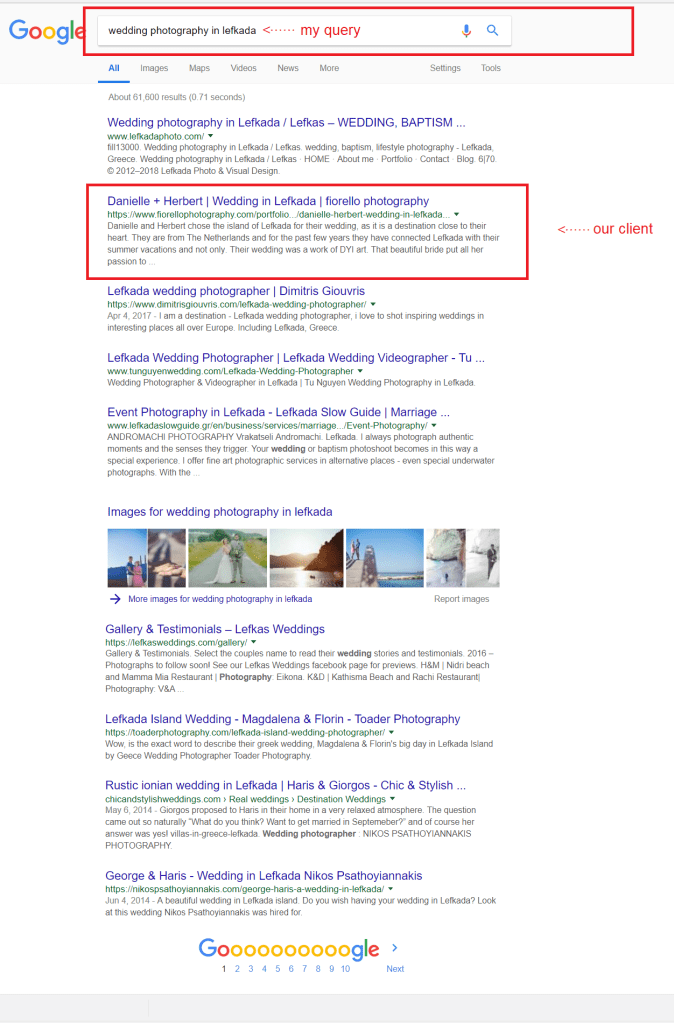SERP
It stands for Search Engine Results Page = SERP
Every time you are searching information for a specific topic into search engine machines like google, yahoo, bing, ask etc you get a list of results. These results are the return answer of the search machines to your query.
For example:
Ι am trying to find a wedding photographer in Lefkada for my best friend’s wedding. And we see one of our clients on the first google page search results.

What factors set the SERP results?
The search engine results page [SERP] can contain two types of answers: organic (not paid) results and paid results. Organic results are everything we see from the data that are retrieved by the search engine’s algorithm. On the other hand, paid results are all the data that are sponsored/ advertised.
The main and most important factor that can put your website’s content at the top and on the 1st Google page results is relevance to a certain query.
Google crawls websites with its Googlebot (search bot software). This crawling process actually visits a vast number of sites to find new information. How does the Googlebot find sites to crawl? It finds them through links.
The given information within sites are gathered by the Googlebot and after that is indexed. And Google uses a hard list of 200 ranking factors to determine the placement of a site in the SERP.
A website needs both on-page and off-page SEO in order to nail all 200 ranking factors. You can learn more about the necessary SEO actions in this article.

Each result displayed on the SERP includes a title, a link that points to the actual page on the Web and a short description showing where the keywords have matched content within the page for organic results.
When it comes to the sponsored results, the advertiser decides what to display and gives priority to the higher bidder.
SERP Types
Major search engines, like Google or Yahoo, may include many different types of SERP enhanced results (organic search and sponsored) such as rich snippets, images, maps, definitions, answer boxes, videos or suggested search refinements. Recent studies revealed that 97% of queries in Google returned at least one rich feature.
 However, the combination of all the above can boost a result to the top of Google’s SERP and keep it there for a really long time. It isn’t a secret that visual and video content is adored both by people and search machines. Some content types have specialized SERP templates and visual enhancements on the main search results page, that makes it easier to find the top answer for a certain query.
However, the combination of all the above can boost a result to the top of Google’s SERP and keep it there for a really long time. It isn’t a secret that visual and video content is adored both by people and search machines. Some content types have specialized SERP templates and visual enhancements on the main search results page, that makes it easier to find the top answer for a certain query.
Search query
When we type a question or a line or a description or just a word, (on the search box) that is called “user search string”. The search box is located on all major search engines like Google, Yahoo, and Bing. You can discover more search engines at this post in Wikipedia. All search machines have a search box where users can enter their query. The topic usually is based on the keywords they enter into the search box in the search engine.
Get better ranking on SERPs
by knowing how to master
the game of communication.
Rich Snippets
As Google explains it: when we use structured data to mark up content, we actually help Google to better understand the quality of the context for display in Search, and we can achieve a better distribution of our content to users from Search. We can do this by marking up content properties and enabling actions where relevant. This makes it eligible for inclusion in rich results.
There is a variety of content types that qualify to appear in rich results. CreativeWork is a schema.org type definition that applies to qualifying content produced for:
- reading
- viewing
- listening
- other consumption, such as news articles, recipes, and videos
Other content types for retail purposes are:
- products
- local business listings
The table below lists the supported features for each content type:

Source of this table: Google.com
Most studies have proven that people tend to view the first results on each SERP. And as you have seen yourself on each page of search engine results usually there are 10 organic listings (however some results pages may have fewer organic listings).
These organic listings, which are on the first page are the most important ones. What makes them stand out and be dragged out by the ocean of digital information within the internet world, relies totally upon their 91% of the click-through rates (CTR) from a particular search.
According to a recent study, the CTR’s for the first page goes as:
TOP 1: 32.5%
TOP 2: 17.6%
TOP 3: 11.4%
TOP 4: 8.1%
TOP 5: 6.1%
TOP 6: 4.4%
TOP 7: 3.5%
TOP 8: 3.1%
TOP 9: 2.6%
TOP 10: 2.4%
Remember that rich snippets are displayed by Google on the search results page when a website contains content in structured data markup. Structured data markup helps the Google algorithm to index and understand the content better. So you better add as many as you can from the following:
Product: Information about a product, including price, availability, and review ratings.
Recipe: Recipes that can be displayed in web searches and Recipe View.
Review: A review of an item such as a restaurant, movie, or store.
Event: An organized event, such as musical concerts or art festivals, that people may attend at a particular time and place.
Software Application: Information about a software app, including its URL, review ratings, and price.
Video: An online video, including a description and thumbnail.
News article: A news article, including a headline, images, and publisher info.
Science datasets
Knowledge Graph: Search engines like Google or Bing have started to expand their data into encyclopedias and other rich sources of information.
Do you want to try it and create your own markup content? Then visit Google’s guide here.
Knowledge Panel
When people search for a business on Google, they may see information about that business in a box that appears to the right of their search results. The information in the box, called the knowledge panel, can help customers discover and contact your business.

Knowledge Graph
The Knowledge Graph is a knowledge base used by Google and its services to enhance its search engine’s results with information gathered from a variety of sources. This information is presented to users in a box to the right of search results. Knowledge Graph boxes were added to Google’s search engine in May 2012. Actually, Knowledge Graph is Google’s way of connecting information.

Knowledge Graph entities
The Knowledge Graph has countless entries that describe existing entities like people, places, and things.
The following are some of the types of entities found in the Knowledge Graph:
- Book
- Book Series
- Educational Organization
- Event
- Government Organization
- Local Business
- Movies
- Movie Series
- Music Album
- Music Group
- Music Recording
- Organization
- Periodical
- Person
- Place
- Sports Team
- TV Episode
- TV Series
- Video Games
- Video Game Series
- WebSite
How to elevate your SERP ranking?
Add high-quality in-depth articles (2000-4000 words) to your content marketing strategy. Include research data, infographics, how-to guides, videos, podcasts, rich information, reviews, testimonials, social media activity, interviews, photographs, events, be active in groups and forums, give exceptional feedback to the search machines giants, use locations and local marketing, use voice search, create unique content, become a contributor at Wikipedia, use paid marketing actions like Adwords and try new features while they are on an early/beta stage.
Author’s Opinion
Social media and in particular Google have altered the way digital marketing interacts with the community. There is a constant competition to gain the attention of people. This is called the Economy of Attention. That urges Google (and all the players) to invest in a better algorithm behavior based on a more AI structure.
Until today we were sure that relevancy was the top factor of SERP rankings. But not anymore… if a consumer gives a low satisfaction signal for a service or product or a location that can affect negatively the ranking score of an entity. In general, AI has focused on a more human-centric evaluation of any given results that we see on the screens of our computers or mobile devices.
So now the power game is between the education of machines to short out which data should include into the process of distinguishing which source is ultimately more trustworthy than another.
We see more examples of even paid results to get lost under the pressure of more reliable sources. As challenging it may seems for the Marketing Industry, on the bottom line this is a good thing.
Having the internet for 20 years in our everyday life, now we have reached a point of a digital adolescence as a society and as individuals. I strongly believe that people tend to pay more attention that the era of passively consuming the digital world has reached its final curtains.
Have you noticed lately, how often search machines are seeking for our feedback? Nowadays we dig dipper, we discuss the dangers and we try to form a safer digital experience by protecting our personal data. Companies hit the wall of people’s reaction to any kind of digital violation.
The IoT reality, where everyone is always connected to everything has restored the balance of power. It is true that machines rule our reality, but this relationship goes both ways. Humans more than ever can control machines, too (and companies behind them).
We are only one click away and with a tremendous power to deactivate a machine/service/product through our portable devices, smartphones, and wearable devices, watches and various other sensors from the comfort of our home.
For all those that they worry about humans freedom and how digital technology can eliminate it, I have a suggestion to share: use the switch off button of any device.
Use the power of “off” whenever you feel like it.
About the Author
Areti Vassou is in Digital Marketing since 1998. Has been awarded several times for Digital Marketing Strategy, Content Marketing & Strategy, SEO Strategy, SEM and Social Media Marketing. Discover more and connect with her on LinkedIn.




Pingback: SEO Check List – IDEADECO
Pingback: How to do Keyword Research like a Pro – IDEADECO
Pingback: Learn to Love SEO like Google – IDEADECO
Pingback: Dive into Quora the Unique World of Questions – IDEADECO
Pingback: Learn How to Use Keywords for your Blog – IDEADECO
Pingback: Google is the Master of Keywords
Pingback: Google is the Master of Keywords
Pingback: SEO Check List